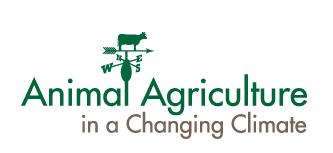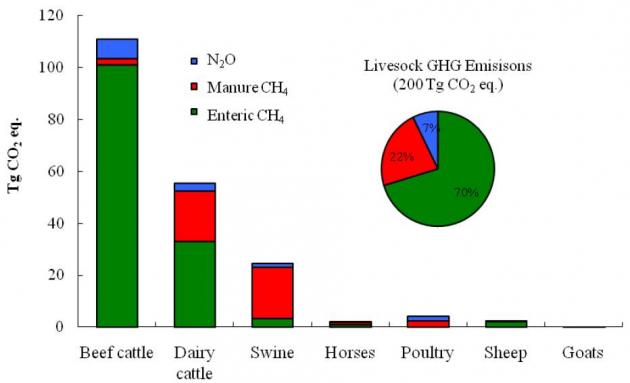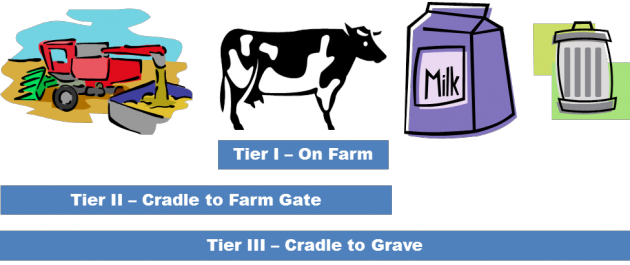Our overall goal is for Extension—working with partner organizations—to effectively inform and influence livestock and poultry producers and consumers of animal products in all regions of the U.S. to foster production practices that are environmentally sound, climatically compatible, and economically viable.
Farm Management Decision Aid Tools
Webcast Presentations
Fact Sheets
Regional Information
Online Certification Course
Brochures/Conference Visuals
Western Region Website-AACC
Farm Management Decision Aid Tools
Integrated Farm System Model (IFSM) and Dairy Gas Emissions Model (DairyGEM) – training presentation by Al Rotz.
Education received through either of these comprehensive model evaluations will lead to the development of more sustainable dairy and beef production systems.
The IFSM (Integrated Farm System Model) is a tool for evaluating environmental and economic effects of different farm management scenarios. The user enters information on cropping practices, facilities, equipment, the herd and other farm parameters. Sample farms of various sizes and types are provided with the model software to provide a starting point. Information generated by the model includes crop yields, feed production and use, animal production, manure handled, production costs and net return to management. The model’s environmental outputs include average annual soil balances of N, P, K and C, erosion of sediment, P runoff, nitrate leaching, emissions of ammonia, hydrogen sulfide and greenhouse gases, and the carbon footprint of the feed, animal weight or milk produced.
The Dairy Gas Emission Model (DairyGEM) is an educational tool that predicts ammonia and hydrogen sulfide volatilization, GHG emissions, and the carbon footprint of the milk produced. DairyGEM is used to study the interacting effects of management changes on major emission sources from feed production to the return of manure back to the land.
About the Presenter:
Dr. Al Rotz is an agricultural engineer at the USDA-ARS Pasture Systems and Watershed Management Research Unit in University Park, PA. His work focuses on the development and use of models to evaluate the performance, environmental impact and economics of alternative technologies and management strategies applied to integrated farming systems for dairy or beef production.
IFSM and DairyGEM Tool Training Presentation
(If one of the video windows is blank, please refresh the page.)
If you are interested in specific segments of the entire video tool training above for either IFSM or DairyGEM, please refer to the separate video segments below.
SEGMENT 1:
Introduction to both the Integrated Farm System Model (IFSM) and Dairy Gas Emissions Model (DairyGEM)
SEGMENT 2:
IFSM tool training (using dairy as an example)
**IMPORTANT Note: this segment also supports the use of DairyGEM
SEGMENT 3:
IFSM beef example and dairy example
SEGMENT 4:
DairyGEM Tool Training
***Note: for further instruction related to DairyGEM use, please refer to Segment 2
DeNitrification-DeComposition (DNDC) Model
DNDC (i.e., DeNitrification-DeComposition) is a computer simulation model of carbon and nitrogen biogeochemistry in agro-ecosystems. The model can be used for predicting crop growth, soil temperature and moisture regimes, soil carbon dynamics, nitrogen leaching, and emissions of trace gases including nitrous oxide (N2O), nitric oxide (NO), dinitrogen (N2), ammonia (NH3), methane (CH4) and carbon dioxide (CO2). In order to download the DNDC model files you will need to register and provide a valid email, as well as your affiliation and intended use. After registration and confirming your email you will be able to download the files from the DNDC Model Download page.
On the Download page, you will find 3 simulation models of interest.
The DNDC model – A computer simulation model for predicting crop yield, soil carbon sequestration, nitrogen leaching, and trace gas emissions in agro-ecosystems.
The Manure -DNDC Model- Ac computer simulation for predicting GHG and NH3 emissions from manure systems.
US Cropland GHG Calculator- A decision support system for quantifying impacts of management alternatives on GHG emissions from Agro-ecosystems in the U.S.
Manure and Nutrient Reduction Estimator Tool (MANURE Tool)
The MANURE Tool provides a system to quantify methane and and other GHG emission reductions and the environmental benefits of renewable energy produced by digesters at dairy and swine operations. The tool is based upon a full and accurate assessment of baseline conditions at the animal feed operation, which is a key element of the emission reduction calculation. This tool can be used to assess the quantity of emission reductions associated with implementation of specific technologies and/or practices. More information about the tool can be found on the Manure and Nutrient Reduction Estimator site.
COMET-FARM
The COMET-FARM tool is a whole farm and ranch carbon and GHG accounting and reporting system. It is intended to help users account for the carbon flux and GHG emissions related to their farm and ranch management activities, and help them explore the impacts to emissions of alternative management scenarios. The tool guides the user through describing the farm/ranch’s management practices including alternative future management scenarios. Once complete, a report is generated comparing the carbon changes and GHG emissions between current management practices and future scenarios. More information about COMET FARM can be found on the COMET-FARM site.
Farm Smart
Farm Smart is designed to give producers the ability to access and mitigate their environmental profile, track and measure their progress, plan for future improvements and report outcomes of practice changes to customers, community members, regulators and other stakeholders. The system features 3 tools: the Farm Smart Environmental Calculator, the Farm Smart Farm Energy Efficiency tool, and the Farm Smart Decision Support tool. Go to the Farm Smart site to download these tools and for more information.
Webcast Presentations
Fact Sheets
Regional Information
United States Global Change Research Program (USGCRP) Information:
Northwest
Northern Great Plains
Southern Great Plains
Southwest
Alaska
Islands
(Hint: These links may take a few minutes to load. If you get a black screen and there is a note on the bottom task bar that says “done”, scroll down a little.)
Newsletters
Fill out the form below to sign up for the Western Region E-Newsletter
Archived Past E-Newsletters
July 29, 2014 E-newsletter
July 11, 2014 E-newsletter
June 27, 2014 E-newsletter
June 13, 2014 E-newsletter
January 17, 2014 E-newsletter
November 22, 2013 E-newsletter
November 8, 2013 E-newsletter
October 11, 2013 E-newsletter
September 20, 2013 E-newsletter
September 13, 2013 E-newlsetter
August 30, 2013 E-newsletter
August 16, 2013 E-newsletter
July 19, 2013 E-newsletter
June 1, 2013 E-newsletter
May 10, 2013 E-newsletter
April 24, 2013 E-newsletter
Animal Ag Climate Change Newsletter Vol. 1, March 2012 (this may take a minute or so to load)
Online Certification Course
This online course is free and was developed to answer questions that the livestock and animal agriculture industry is facing related to climate. Nationwide, producers and stakeholders are asking questions about climate change: Is it happening? Are unusual weather patterns and events becoming more frequent? Should we be planning and managing for the future? Where can we get un-biased information that serves the livestock and ag community?
This online course will provide valuable information from which to feel confident in answering these frequent questions. Also, the online platform eliminates the extra travel expense for professional development.
Students that take this course will learn about the areas of climate and weather trends, impacts, adaptation, mitigation, policy, climate science and effective communication. Upon completion, they can receive CEUs from multiple professional societies.
Or please contact Liz Whitefield at e.whitefield@wsu.edu if you have any questions.
Brochures/Conference Visuals
Brochure: Animal Agriculture and Climate Change (this may take a minute or so to load)










